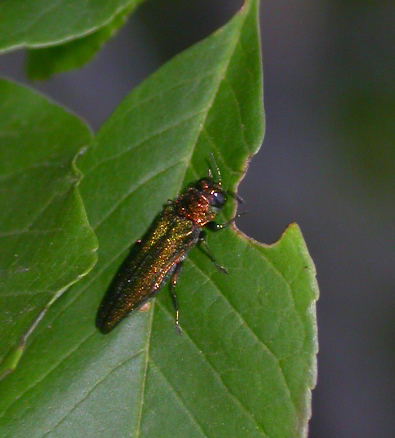Homeowners play key role in discovery of emerald ash borer
By Jennifer Stewart
Ag Communications
Monday, June 19, 2006
 |
Adult EAB feeding on the edge of an ash leaf.
Image Credit: Jodie Ellis |
WEST LAFAYETTE, Ind. - As the emerald ash borer continues to be found in Michigan, Ohio, Indiana and now Illinois, homeowners are playing a crucial role in identifying infested trees.
Emerald ash borer is a devastating Asian beetle that destroys ash trees. It was discovered near Detroit in 2002 and is responsible for the death of at least 15 million ash trees in the quad-state area.
Most recently, a homeowner near South Bend, Ind., in St. Joseph County discovered Indiana's most recent case. A similar scenario also took place in St. Charles, Ill., where another homeowner discovered an infestation and reported it to authorities.
"In several instances, it has been the homeowner who has reported emerald ash borer to us," said Purdue University entomologist Jodie Ellis. "Homeowners are our most powerful weapons against the spread of the insect because they are the ones out there checking their ash trees and they are often the ones who raise the alarm.
"To slow the beetle down and gain control over it, we first have to know where it is and place those areas under quarantines. If people keep moving the beetle unknowingly, we may not be able to save the ash resource in North America."
Because of their vital role in halting the spread of emerald ash borer, it is important that homeowners know what to look for and what to do if they find the pest, Ellis said.
First, homeowners should learn to identify ash trees and locate them on their properties. They should then examine their ash trees periodically for symptoms of emerald ash borer infestation. Symptoms of an infestation include thinning of tree leaves starting at the top of the tree; tiny, D-shaped exit holes nearing one-eighth of an inch in diameter on the limbs and trunks of the tree; and the presence of curvy, S-shaped larval feeding tunnels under the tree's bark.
In its adult stage, the beetle merely nibbles on the leaves of ash trees, causing minor damage. However, in its larval or immature form, the insect feeds on the ash tree's vascular tissue located under the bark, inhibiting the tree's ability to transport water and nutrients.
If signs of emerald ash borer are present, homeowners in Indiana should contact the Department of Natural Resources at 1-866-NO-EXOTIC or Ellis at (765) 494-0822.
Additional resources on detecting emerald ash borer can be found on the Purdue entomology Web site or at the USDA emerald ash borer web site .
Writer: Jennifer Stewart, (765) 494-8402, jsstewart@alumni.purdue.edu
Source: Jodie Ellis, (765) 494-0822, ellisj@purdue.edu
Ag Communications: (765) 494-2722; Beth Forbes, forbes@purdue.edu
|